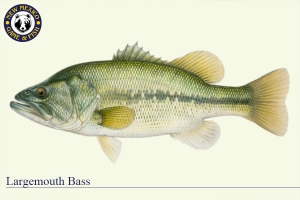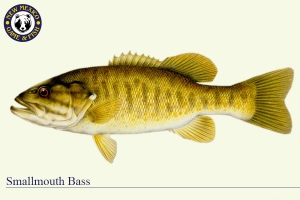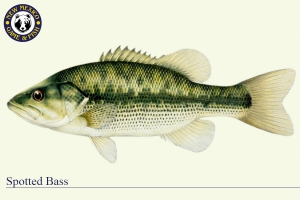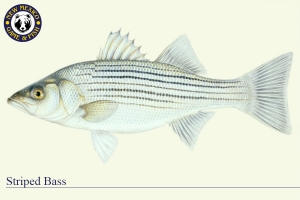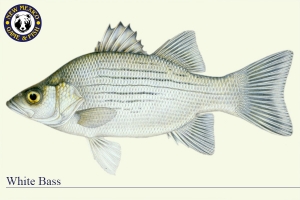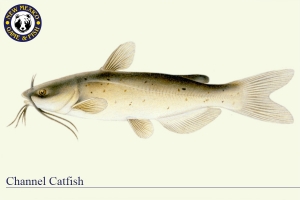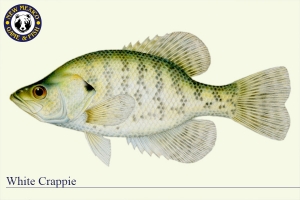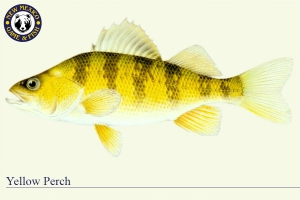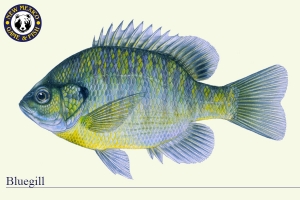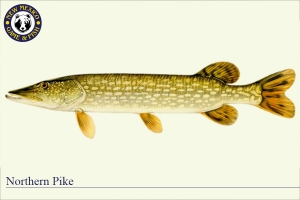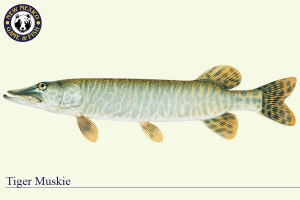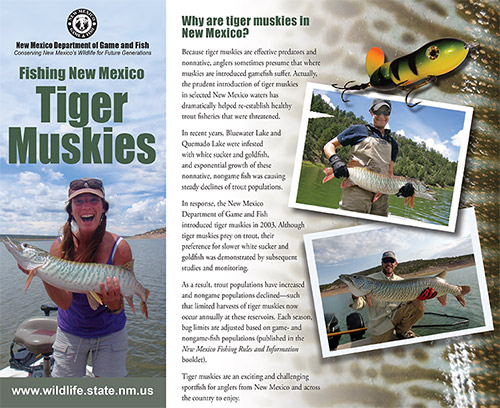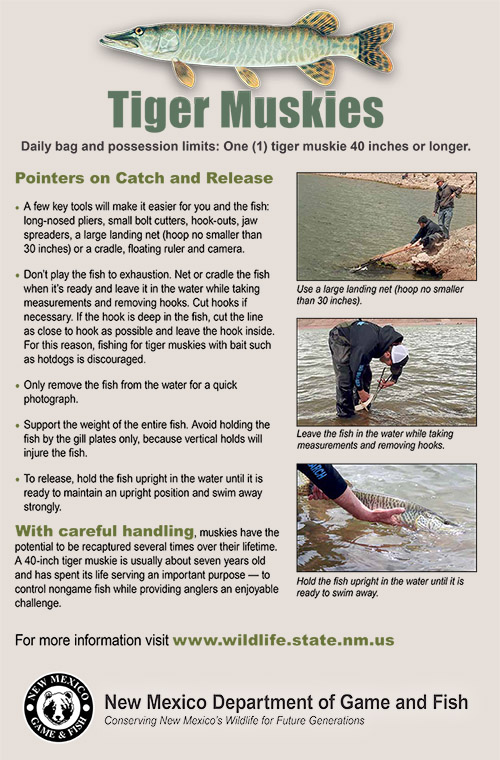Warm Water Species
Click the tab headings below to learn more about fishing for New Mexico state warm water fish species including: black bass, temperate bass, catfish, panfish, pike, muskie, and walleye.
Black Bass
Aggressive Fighters
Pound for pound, black bass are the most aggressive gamefish in New Mexico. Originally found east of the Mississippi, black bass (which include primarily the largemouth and smallmouth species, but also spotted bass in a few reservoirs) have been transplanted throughout the West.
With voracious appetites and short tempers, black bass readily feed on small fish, crayfish, worms, lizards, insects, mice, small birds, and frogs. They also strike on lures. Black bass and their food are usually found in and around cover, called “structure.” Black bass typically hide next to logs, docks, underwater ridges, submerged brush and rocks, or near an abrupt drop-off.
In New Mexico, black bass start spawning when water temperatures reach 63 degrees. The male selects a sunny spot in gravel shallows, courts a female, and persuades her to deposit eggs in his nest. The male discharges milt to fertilize them, then guards the eggs until they hatch.
Largemouth Bass
The largemouth bass is a sturdy, greenish-colored fish with a horizontal dark stripe along its side. Its upper jaw is big in proportion to its body, extending beyond the eye. The largemouth spends most of its time in its home range– a small, concealed area of deep cover– quietly waiting for food to come its way. Elephant Butte, Ute, and Conchas are our best largemouth reservoirs.
Smallmouth Bass
Smallmouth bass are typically bronze-colored, with dark, vertical stripes or blotches. The upper jaw is small and does not extend beyond the eye. In New Mexico, ‘bronzebacks’ are found in cool-water reservoirs, as well as in portions of the Gila River. They prefer rocky underwater habitat. Ute, Conchas, Navajo, Elephant Butte, and Abiquiu are our best smallmouth reservoirs.
Of all New Mexico reservoirs, Ute, Conchas, Navajo and Elephant Butte are best for bass fishing. Other New Mexico bass fishing reservoirs include Caballo, Cochiti, Bill Evans, Santa Rosa, Abiquiu, and Sumner.
Spring Bass Fishing
Pre-Spawn: 50-60 degrees at 5-20 feet deep
The warming temperatures of spring draw the bass into shallow waters where they actively feed until spawning. March through June are New Mexico’s prime bass fishing months. As water temperatures start climbing above 50 F., bass begin to feed aggressively. Use a spinnerbait right on the bottom.
Post-Spawn: 55-65 degrees, less than 10 feet deep
Use slow rolled spinner baits, shallow running crankbaits, worming or flipping worms, salt craws, lizards, and jig’n pig combinations for bass in less than 10 feet of water. As bass become more active, use jerk baits. All of these can be easily used from boat or bank.
Summer Bass Fishing
65 degrees and warmer | 1-20 feet deep
As upper lake layers warm, bass typically go deep to cooler waters. In summer, bass only come to the surface to feed, generally before dawn and after dusk, though bass will feed on the surface anytime their food is there. When bass are on top, use buzzbaits or propbaits. When bass are deep, fish a light line and split shot, with small plastic worms or grubs, off rocky or brushy lake points.
Fall & Winter Bass Fishing
40-65 degrees at 1-60 feet deep
Fall fishing is the reverse of spring. Retrieve faster in early fall and slower in late fall. In winter, go very deep and extremely slow off lake points with jigging spoons and small plastics.
Where To Find
Largemouth Bass Some of the best largemouth bass fishing can be found in New Mexico’s smaller lakes. Clayton, Bill Evans and Lake Roberts can offer trophy-sized fishing opportunities. Fishing at Conchas and Elephant Butte lakes should be good. Concentrate on structure where available.
Smallmouth Bass Smallmouth bass populations are very good at Navajo Lake, Ute Lake and Conchas Lake. Though the highest abundance can be found at Navajo, Ute and Conchas have good numbers of larger fish as well. Numbers and size also have improved at Elephant Butte Lake. Smallmouth bass typically gravitate around rocky areas and ledges year round. Concentrate fishing efforts in these locations.
White/Striped Bass
Predators of the Open Waters
White bass and striped bass are members of the temperate bass family: true basses, separate and distinct from largemouth and smallmouth bass which are actually members of the sunfish family. Temperate bass are found primarily in fresh waters, although there are anadramous species that spend part of their life cycle in the sea.
Both white bass and striped bass have so-called “false gills” on the inside of their gill covers and three anal fin spines. Both of these bass species feed almost exclusively, and with relentless voracity, on shad and other forage fish.
White Bass
Also known as sand bass, sandies, and silvers, white bass were first stocked in New Mexico in 1959. Smaller and chunkier than their striper cousins, white bass typically weigh about 1 to 1.5 pounds; a white bass weighing more than 2.5 pounds is highly unusual. Other white bass characteristics include silvery-white sides, marked by a series of horizontal stripes, only one of which extends to the tail. Except during spawning, white bass stay on the move in a continual search for food, along shorelines in open water.
Striped Bass
Striped bass were first introduced into New Mexico in 1972. Depending on available food, these bass may exceed 55 pounds, although most stripers caught in New Mexico range from 5 to 20 pounds. Striped bass are known by their elongated bodies, pale olive to blue backs, silvery sides, and seven-to-eight horizontal stripes, most extending to the tail. Locating striped bass is harder than catching them, because they’re wanderers of open waters. Stripers are hearty eaters, most actively feeding in water temperatures between 70 and 72 degrees.
Fishing for White & Striped Bass
White Bass:
White bass are the most frequently caught, warm-water sport fish in New Mexico. These lively fish have a voracious appetite, strike eagerly at lures once waters warm, are relatively easy to catch, and make good eating.
As schooling fish, white bass tend to gather in high numbers, avoiding more turbid waters. Although white bass prefer deep, open water, they will surface to strike at a school of shad.
To catch white bass, use ultra-light spinning tackle on a 5- to 6-foot rod. Six pound test line works best. Try jigs and flashy spinner-jig combinations: white, yellow, silver, or chartreuse, with reflective tape on the spoons and polished spinners. Any small lure that looks like a shad will catch white bass when a school is located. Also try crankbait spoons, minnow imitation plugs, jigging spoons, and propellered surface lures. Topwater plugs that sputter are good to use when white bass feeding is in full force. In spring, shore fishing for white bass can be fantastic.
Striped Bass:
Look for stripers in Elephant Butte and Caballo Lakes at depths between 20 to 50 feet, sometimes suspended over much deeper water. They may locate over old creek beds or channels, near sunken islands, along ridges with adjacent drop-offs, or near bridges. In fall, stripers move into shallow flats and chase schools of shad near the surface. Fall can be an exciting time for striper fishing, compared with winter, when stripers tend to stay deep and roam less.
For best results, use a depth finder. As waters warm, try trolling with live-bait shad or bluegill. When using bait, always use a fresh specimen; replace lethargic bait frequently. Try still-fishing with live bait from an anchored boat or slowly adrift. Use 1-1/2 to 4 ounces of lead in a bead-chain weight to keep the bait at the proper depth. When you locate stripers holding in deep water, try jigging or trolling with a downrigger.
Best Waters
Striped Bass: Elephant Butte and Caballo Lakes.
White Bass: Elephant Butte, Caballo, and the Rio Grande between the two reservoirs; Cochiti, Brantley, Sumner, and Ute Lakes.
Spawning
White Bass:
Although white bass spawn very successfully in New Mexico waters (particularly Elephant Butte Lake), 70 of every 100 white bass spawned each year are caught by fishermen or die of natural causes. The low egg hatching success and high mortality of adults means a great number of eggs must be spawned to ensure good fishing. During mid-April to mid-May, when water temperatures reach 54 to 73 degrees, white bass begin spawning in large reservoirs, where they seek out gravel or rocky bottoms in shallow water upon which to deposit eggs.
Striped Bass:
It is doubtful that striped bass successfully reproduce on their own in New Mexico waters. Because of this, young striped bass are frequently stocked by the Department of Game and Fish at Elephant Butte Lake to maintain a population of trophy-sized stripers for anglers.
Pointers from the Pros: White and Striped Bass Fishing
- Watch the action of gulls or other fish-eating birds at a reservoir. Check out where they’re surface feeding on small fish. Where gulls are feeding, there will be schools of white bass as well. Try ‘jump fishing’: get to the action area quickly, throttle back upwind, shut off the motor, and drift down through surfacing fish.
- Once you make a catch at a school of surface-feeding bass, try again and again. Such feeding eruptions last only a short time, usually in late afternoon or early morning, especially in late summer and early fall.
- Medium-to-light action spinning and baitcasting gear are good choices for white bass fishing.
- Best times to fish for stripers and white bass: daytime from late fall through early spring; late evening through first light in summer.
- Use jigs or crankbaits in spring and summer, baitfish in fall, using a heavy rod and line. Live shad is a good, all-around bait.
- Striped bass that are near structure (submerged trees, formations) seem to be more active — and willing to bite — than stripers that are suspended in mid-depths.
- To catch more than one bass at a time, place two or more reflective lures simultaneously on your line at 18-inch intervals. Try jigs or jigging spoons.
- In reservoirs, look for riprap on shorelines, rocky points, just off islands, sudden drop-offs, old river channels or sand bars. In rivers, check out places where streams enter, bridge pilings disrupt current flow, above wing dams, or downstream from a lock and dam.
- Use a depth finder to locate schools of bass. They prefer sandy or gravel lake bottoms. No matter where you find them, they aren’t going to stay in one place long.
Where To Find
White Bass Fall surveys have indicated that white bass populations are highest at Conchas Lake and Ute Lake. During the past year, white bass numbers have improved slightly at Elephant Butte and Caballo. Fishing from late spring to early summer in areas where shad or other forage fish congregate could provide exciting opportunities.
Catfish
Nighttime Fighters
Channel and flathead catfish each have eight black barbels (whiskers) near the mouth and thick, smooth, scaleless skin. Their fins are dark and soft, except for portions of the dorsal and pectoral fins, which are sharp, serrated, and can be venomous. Nighttime is when catfish come alive for most fishermen. During the day, catfish seek out dark, deep pools with submerged logs, rocks, or other debris.
Flathead Catfish
The flathead is most easily distinguished from the channel by its mottled coloration, gray to yellowish-brown. Other identifying marks are its flattened head, jutting lower jaw, very large mouth, and squared tail fin. Flathead catfish don’t mature until they reach 15-19 inches. They may live up to 25 years, continuing to grow as they age. A flathead tends to have a home range, spending most of its time in a resting spot which it will defend from other fish, including other flatheads.
Channel Catfish
This species is widely distributed in New Mexico because it has adapted well to life in reservoirs. Young channel catfish are silvery blue-gray with black spots and a forked tail. Once they reach maturity, at about 12 inches, their coloration darkens markedly and their spots diminish. Although channel cats prefer clear, slow-moving water, they’re highly tolerant of turbid water. They can grow to over 30 inches, though 12 to 16-inchers are more common catches in New Mexico waters.
Spawning
In New Mexico, catfish spawn from spring through mid-summer. Exact timing is regulated by latitude and water temperatures. The ideal time is when water temperatures are between 72-84 degrees. River channel cats migrate upstream to spawn. In rivers or reservoirs, the male catfish selects a nest site in protected locations, such as bankline holes or under flat rocks. Egg production varies, from 3,000 to 100,000 eggs, depending on the size of the female. Fertilized eggs hatch in about a week, and males guard the fry, herding them together near the nest. Young catfish school tightly after hatching. One of the parents often stays nearby to ward off predators.
Fishing for Catfish
Catfish tend to feed by night, especially after summer rains when they search turbid waters with their barbels for food.
In spring and early summer, when water temperatures are between 60 and 72 degrees, catfish are fairly easy to catch — so long as you remember to fish the bottom when the sun is off the water. The only thing that affects a catfish appetite is water temperature. Below 40 degrees F., it has no interest in feeding.
During daytime hours, murky backwaters of coves or slow-water stretches of river are good places to fish from the bank or with waders (check out the bottom structure first). Use a float, small weight, and chunks of bait or bait on a hook by itself.
Daytime fishing is best for flathead cats, especially from May through early June, and again from July through September, when they’re active. If you’re fishing for big flathead, make sure your bait is large, weighs a pound or more, and is alive. Try suckers, carp, shad, or sunfish, provided these are already present in the water.
Baited Holes
One time-tested method for catching catfish is the baited hole technique. Prepare a five-gallon bucket of whole wheat (or whole milo purchased from a feed store) and water. Let it ferment for 3 to 4 days — add some dry cat food to the mixture if you like. Meanwhile, select a likely fishing spot, 20 to 30 feet deep, where you can easily anchor or tie off your boat. Once the mixture has fermented, determine the day you want to fish; the day before, pour half the contents of the bucket into the fishing hole, making sure it sinks effectively. The next day, pour about a half gallon into the same spot, move away from the area for an hour, then return and start fishing. Make sure chumming is legal in the waters you want to fish. Check the fishing regulations or call the Department for details.
Best Catfish Waters
Reservoirs: Ute (best for both species) and Bluewater (good mid-day summer fishing for channel cats; use lead sinkers on the bottom). Also Elephant Butte, Cochiti, Caballo, Navajo, Brantley, Conchas, Abiquiu, Sumner, and Santa Rosa. Smaller lakes, such as Bear Canyon, Eunice, and Jal, are stocked with channel catfish. Clayton Lake (black and yellow bullhead).
Rivers: Gila (Gila Hot Springs downstream to the Arizona Line); portions of the San Francisco; portions of the Rio Grande; Rio Chama (between Abiquiu and El Vado dam); Percha Dam; and stretches of the Pecos River below Sumner and Brantley reservoirs. In rivers, both species tend to congregate around brushpiles and holes below sandbars.
Fishing for Catfish: Pointers from the Pros
- Serious catfish angling is done with bait. Try shrimp, chicken or beef liver, worms, and cut bait for bottom fishing.
- Use slip sinkers but leave the bail open.
- ‘Chumming’ a baited hole is legal in New Mexico only in certain waters. Check first, and take only those catfish you plan to eat.
- Use live bluegills as legal bait to fish for large flatheads.
- Channel cats bite on stinkbait, whether homemade (form a mixture of cheese, decayed meat or minnows, animal blood, oats, flour, and anise into small balls) or commercially prepared.
- Tackle can vary from a simple throw line to heavy-duty rods and reels.
- Besides stinkbait, channel cats also hit on night crawlers, animal entrails, frogs, grasshoppers, clams, crayfish — also artificial baits, such as plugs, spoons, jigs, spinners, and plastic worms.
Where To Find
Channel Catfish Catfish numbers and sizes are highest in New Mexico’s larger reservoirs. Elephant Butte, Conchas, Caballo and Ute all have very good populations with some very large fish. Shallow murky water near inlets provides good fishing during late evening and night.
Panfish
What are Panfish?
The term “panfish” tends to have a regional meaning, depending on locale. In some places, locals call small trout panfish, while in other areas, it can mean any small fish that comfortably sizzles in a frying pan.
In New Mexico, panfish typically refers to the following four, closely related species: white crappie, yellow perch, green sunfish, and bluegill. All tend to be small, laterally flattened, have vertical barring along their sides, and a varying number of stiff, sharp spines on their anal fin.
These fish are usually easy to catch and make great eating. Catch them, clean them, scale them, and fry them — it’s that simple and delicious.
Descriptions
White Crappie
The white crappie is a member of the sunfish family, which also includes largemouth and smallmouth bass. This handsome, olive-colored fish has a silvery cast to its coloration, as well as 7-to-8 indistinct vertical stripes along its sides. It adapts easily to a variety of conditions, particularly warm turbid waters with protective cover, such as boulders and submerged brush piles or trees. White crappie may be found in intense spawning schools during a ‘good’ year. Young white crappies feed on zooplankton, then switch to insects and tiny fish as they grow and mature.
Yellow Perch
The only freshwater fish with a yellow-hued body, the yellow perch has 6-to-8 distinct, black, vertical blotches along its sides. With its tiny, brush-like teeth, yellow perch feed upon zooplankton and aquatic insects and are preyed upon by walleye and black bass. It prefers cold, clear, pond-like habitats. Because yellow perch can tolerate low oxygen levels, it usually survives winterkill conditions that often suffocate other species. Yellow perch are prolific and can easily overtake a small body of water, producing a population of stunted individuals.
Green Sunfish
This Great Plains species is distinguished from other panfish by its very large mouth and short, rounded pectoral fins. Its body is olive-brown with 7-to-12 vertical bars along its side. The green sunfish lives in ponds, shallow lakes, and in river backwaters. Native to the Pecos and Canadian River drainages, the green sunfish was introduced into other New Mexico drainages during the 1930s.
Bluegill
Anglers can find feisty, 5-to-7-inch bluegill in almost any warm New Mexico waters. An iridescent blue color on the lower jaw and gill cover gives the bluegill its common name. With a rounded flat body, small mouth, and olive-brown back, the bluegill has 5-to-9 indistinct vertical double bars along its sides. This species was initially transplanted throughout various New Mexico waters during the 1930s; since that time, subsequent reintroductions have kept population numbers strong.
Best Waters for Panfish
White Crappie
Best fishing waters: Conchas and Navajo Lakes. Also southern portions of both the Rio Grande and Pecos Rivers, Ute Lake, Cochiti Lake, Caballo Lake, and Elephant Butte Lake.
White crappies are found in most major New Mexico reservoirs. Crappies tend to be more light sensitive than other panfish. In late-evening dimness or at dawn, crappies tend to hold along the outside edge of weedlines, seeking safety from predators in the vegetation. As the sun climbs, crappies seek protective cover of boulders or submerged trees. At mid-day, they often suspend at depths up to 30 feet. During winter, crappies stay deep and are relatively inactive.
Yellow Perch
Eagle Nest, Lower Charette Lake, Springer Lake, Stubblefield Lake.
Look for yellow perch in shoreline areas of clear lakes and ponds with a moderate amount of aquatic plant life, or in pools and backwaters of rivers. Perch tend to be bottom dwellers, seeking the cover of low-growing vegetation on flats where they hold at the base of weeds and tend to bite throughout day. Perch form into spindle-shaped schools, numbering 30-100 individuals, that move about during the day in deep water. After dark, yellow perch disperse, move to the bottom, and remain motionless. At daybreak, schooling activity resumes.
Green Sunfish & Bluegill
Green Sunfish: Populations occur in portions of the Canadian River and Rio Grande, as well as the Pecos, Gila, and Black Rivers. Smaller populations occur in other waters and small, warm pond habitats.
Bluegill: Elephant Butte Lake, Sumner Lake, Santa Rosa Lake, Ute Lake, Conchas Lake, and small warm-water ponds.
Bluegill and green sunfish are such adaptable species, they can easily overpopulate a lake. They like a combination of warm weather and warm water, although bluegills tend to avoid direct sunlight. In shallow lakes, these fish swim together in small schools of 10 to 20 individuals of similar size. They feed most aggressively in water temperatures between 64 and 72 degrees. Green sunfish are probably the most tolerant and adaptable of New Mexico panfish. Aggressive feeders, these panfish will take almost any bait.
Pointers from the Pros: Fishing for Panfish
White Crappie
- On dark, cloudy, or windy days, crappies approach the surface and shore more closely. Expect an all-day bite.
- Once you’ve caught one crappie in a given area, chances are you’ll catch more. Try at least a dozen or more casts, then more to a different stretch of shoreline.
- Use small crankbaits, spinnerbaits, or a lead-head jig with marabou feathers, or a plastic tube jig to catch crappie.
- In winter, when crappies go to 40 feet, try jigging with minnows or small lures on light tackle.
- To fish for crappies by night, use minnows or jigs under small floating lights directed downward, or with a float and a lantern.
- Cast a small tube jig on 2- to 4-lb. test line into any irregularity in the weedline that might hold crappies.
- If an insect hatch is in progress, check for crappies near the top at dawn and dusk. When they are feeding at the surface, try still fishing a small buoyant dry fly. As the sun climbs, surface activity diminishes.
- Use a long crappie pole, no reel needed, during the crappie spawn.
Yellow Perch, Green Sunfish & Bluegill
- Use an open-faced spinning reel, small wire hook, live bait, and a small sensitive bobber. Yellow perch will eat just about anything — snails, insects, young crawdad, minnows, and small fish.
- Green sunfish and bluegill prefer to feed on insect nymphs in early spring. Caddis fly, mayfly, dragonfly, and damselfly nymphs on a fly-rod, or other light tackle, provide great action.
- To fish for yellow perch, use worms, small minnows, insect larvae, crawdads, shrimp, or pieces of fish.
- Keep trying different locations, because perch are always on the move. Because they tend to feed near the bottom, start looking for schools there.
- Since schools usually contain fish of a similar size, check out new locations for different schools if only small perch are biting where you are.
- Yellow perch feed most actively during the day, especially early morning and late afternoon, and become inactive at night. Remember, perch nibble at bait. They don’t usually hit with a strike.
- In spring, yellow perch stay close to shore during spawning. As temper-atures rise in summer, they move to open waters. In winter, they suspend deeply and become inactive.
Muskie / Pike
Where To Find – Tiger Muskies
Tiger Muskie are a cross between the northern pike and muskellunge. Quemado Lake supports a healthy population of tiger muskie. Anglers fishing at Quemado Lake can expect opportunities to catch a variety of different sized fish. Bluewater Lake currently supports a high-density population of tiger muskie. Anglers can expect above average catch rates for most of the summer at this lake. The length limit for tiger muskie at both lakes is 40 inches. The daily bag limit and possession limit are the same—one (1) tiger muskie 40 inches or longer.
Catch and Release – Tiger Muskies
Pointers on Catch and Release
A few key tools will make it easier for you and the fish: long-nosed pliers, small bolt cutters, hook-outs, jaw spreaders, a large landing net (hoop no smaller than 30 inches) or a cradle, floating ruler and camera.
Don’t play the fish to exhaustion. Net or cradle the fish when it’s ready and leave it in the water while taking measurements and removing hooks. Cut hooks if necessary. If the hook is deep in the fish, cut the line as close to hook as possible and leave the hook inside. For this reason, fishing for tiger muskies with bait such as hotdogs is discouraged.
Only remove the fish from the water for a quick photograph.
Support the weight of the entire fish. Avoid holding the fish by the gill plates only, because vertical holds will injure the fish.
To release, hold the fish upright in the water until it is ready to maintain an upright position and swim away strongly.
 Tiger Muskie Poster Catch-and-Release Pointers
Tiger Muskie Poster Catch-and-Release Pointers
Walleye
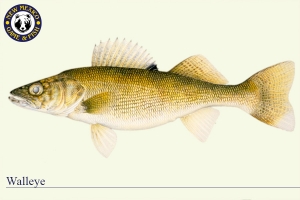
Deep Water Predator
With a mouthful of needle-sharp teeth and jutting lower jaw, the walleye is a formidable predator. In New Mexico, the walleye is considered a creature of the depths, hovering in dark waters far below anglers on the surface. This species avoids sunshine and calm water, preferring winds (3-10 mph), small surface waves, and depths (20-60 feet). It is not unheard of to catch walleyes in 90 feet of water. Water temperature has a great deal to do with where walleyes locate.
As a species, walleye are highly adaptable and multiply so rapidly they tend to take over new waters, preying upon resident fish. Good walleye habitat requires an ample supply of forage fish, 2- to 5-inch fingerlings, including shad, yellow perch, and crayfish. Walleye are at the peak of feeding in 64-degree water.
Every March, the New Mexico Department of Game and Fish collects millions of walleye eggs, mostly from Ute and Conchas reservoirs, for artificial propagation at the Rock Lake Hatchery. Up to 40 million walleye eggs are hatched and nurtured, then stocked as fry in area reservoirs.
Walleyed Pike
Despite its official name and pike-like appearance, the walleye is actually a member of the perch family. The walleye is named for its blind-looking “wall” eyes, which are milky white, to help it see and feed in near darkness. It is a cylindrical, solid-bodied species with two tall, stiff dorsal fins, and the front fin is sharp with hard spines. Hazy color bands cross its back along its greenish-brown sides, above a cream-colored belly. A silver spot marks the bottom rear tip of the tail fin.
Winter Jigging
In reservoirs, use heavy (3/4 to 1 1/2 oz.) vertically shaped jigging spoons along the edges of old river channels at depths of 100 feet or more. Winter walleye fishing is most successful when your boat is equipped with a depth finder.
Spring Walleye Fishing
Best spring fishing action is on windy days during April and May, just after the spawn. Spawning occurs in water from 42 to 56 degrees F. Look for walleyes to gather and spawn in gravelly or sandy bays (where prevailing spring winds stir up wavelets), off shoreline bars, or in open water gravel flats. Moderate wave washing is needed to assist eggs in hatching. Reservoir walleyes spawn over a three-week period, primarily after dark, in water depths of 3 to 12 feet.
On cloudy, breezy days, it is not uncommon to catch walleye in less than 10 feet of water in areas where you’d normally expect to find largemouth bass. Under these conditions, use small jigs tipped with minnows, shallow running crankbaits, spinners, plastic worms, salt craw, and curly tail grubs.
Summer Walleye Fishing
In summer, walleyes frequent sand bars and points mostly at night, feeding on crayfish and minnows. For summer bait, most walleye fishermen use minnows, worms, bottom bouncer rigs, or wide-wobble crankbaits. As waters warm throughout the season, walleyes move further and deeper into cool, dark waters. While moving to these depths, walleyes are often attracted to structure, such as islands, underwater land forms, or deep weed beds.
As fall approaches, they return to their spring habits, such as frequenting shallower water and rocky structure, and returning to an all-fish diet again as they fatten up for winter.
Best New Mexico Valley Reservoirs
Ute and Conchas (historically, our best walleye waters); Caballo (a close second); Santa Rosa, Cochiti, Clayton, Sumner, and Abiquiu.
Fishing for Walleye: Pointers from the Pros
- Summer walleye fishing is easier if you use a depth finder.
- A quarter-ounce lead-head hook with a yellow curly-tail grub is a favorite for both deep and shallow fishing. Tipping your hook with bait, whether worms or a piece of baitfish, can increase your chances.
- Fish from shore using live bait on sinker rigs or jigs.
- After dusk along the shore, cast a 5- to 7-inch shallow-running crankbait in 2 to 7 feet of water full of perch or bluegill, yet still near deep water. Wear chest waders, fish quietly, and bring a net.
Where To Find
Walleye Recent surveys indicate the highest and most stable populations of walleye are found at Caballo Lake. Ute Lake and Conchas Lake also should provide good numbers of walleye. Fishing is usually best during April and May, after fish have spawned.
 Sport Fish Restoration Act
Sport Fish Restoration Act
A 10-percent federal excise tax on your purchase of fishing equipment and motor boat fuel helps states individually promote sport fisheries. This includes acquiring easements or leases for public fishing, funding hatchery and stocking programs, supporting aquatic education programs, and improving boating facilities for anglers.

